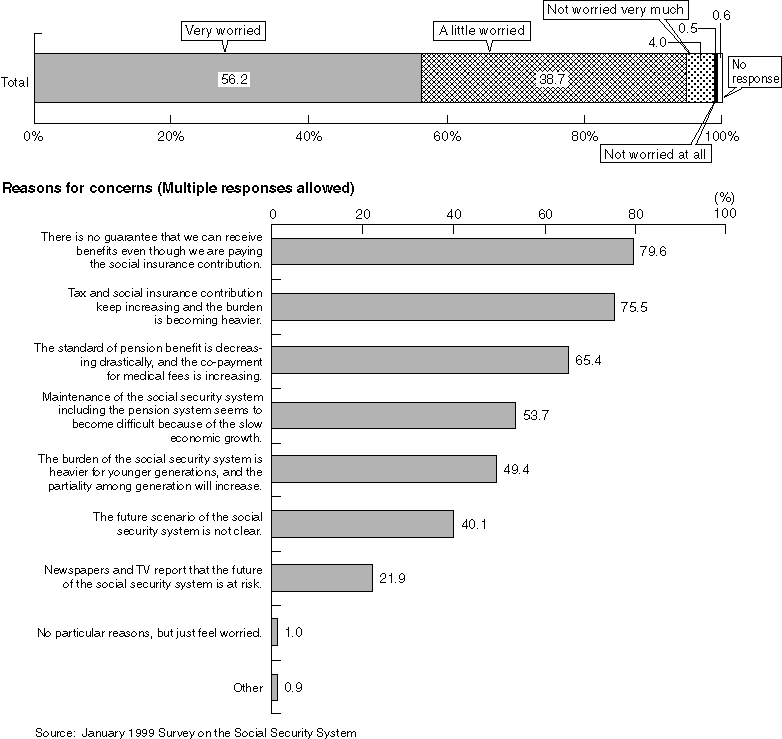
1-1. Insecure Feeling for the Advanced Age
As explained in Chapter 1, varieties of measures have been taken particularly from 1980s to present time in the area of social security systems to be prepared for the full scale of aged society in the 21st Century. Such measures include the establishment of health service system for the elderly, the formulation and promotion of Ten-Year Strategy to Promote Health Care and Welfare for the Elderly (the Gold Plan), improvement of regional welfare led by municipality, revision of the public pension system, formulation of the Basic Law of the Aged Society Strategy, the establishment of the long-term care insurance system, etc. As analyzed in Chapter 3, the outcomes of these efforts are contributing to stable living of elderly-only households and it is particularly apparent to the elderly in the redistribution function of the social security benefit through the pension and medical care systems. The standard of the social security system for the elderly has been reaching a high level in terms of both mechanism and the contents of the system.
However, it is also true that there are many people who feel insecure about their life in old age.
According to "1998 Survey on the National Living Preferences" (Social Policy Bureau, Economic Planning Agency), 73% of citizens over 20 years old are concerned about their lives in old age. Compared to the responses to a similar question in the "Public Opinion Poll on the Welfare for the Elderly" (1986) by the Prime Minister's Office, the number of people feeling insecure is increasing for both men and women of all ages. In case of the people in their 20s and 30s, less than a half of the respondents expressed concerns in 1986 survey, and the number increased to 50% and 70% in the current survey respectably. In the comparison of concerned areas, the ratios for the "economic concerns (living expenses, etc.)" and "concerns on health related issues" are almost 20 points higher now than the responses in 1986, and their percentages are reaching about 50%. In addition, "concerns for long-term care" has increased more than 20 points to reach approximately 30%. It is possible that recent economic conditions, difficult environment for employment and increasing interests in the issue of long-term care are affecting psychologically.
1-2. Concerns About the Social Security System
Japan has achieved the world-highest economic power, high salary standard, affluent consumer living, high saving rate and the well-established social security system, but why do we have many people worrying about their living in their advanced age?
And, why is the ratio of people worrying about their old age high among younger generations? The background to this worry is that there are many people concerned about the future of the social security system which aims for the stability and security of people's living.
According to the "January 1999 Survey on the Social Security System", about 60% of the working generation responded to the question on the future of the social security system, "very worried", about 40% responded "a little worried", and less than 5% responded "not worried" (Figure 4-2-1). The data by age group shows that the ratio of the people feeling worries increases in older generations.
Figure 4-2-1. Concerns about the Future of the Social Security System

The most common reason for such concerns was "There is no guarantee that we can receive benefits even though we are paying the social insurance contribution" (79.6%), followed by the reason "Tax and social insurance contribution keep increasing and the burden is becoming heavier" (75.5%), "The standard of pension benefit is decreasing drastically, and the co-payment for medical fees is increasing" (65.4%), "Maintenance of the social security system including the pension system seems to become difficult because of the slow economic growth" (53.7%), and "The burden of the social security system is heavier for younger generations, and the partiality among generations will increase" (49.4%), etc. The number of people worrying about the increasing burden and heavier burden on younger generations is higher in younger generations. The number of people worrying about the difficulty in maintaining the social security system due to the low economy is higher in older generations.
Thus, the reasons for the concerns about the social security system are heavier burden in the future, uncertainty about the availability of benefit and potential for the decrease of benefit after paying the insurance contribution, difficulty in maintaining the system, and the different burden among different generations.
1-3. Too Much Worries is not Necessary with the Social Security System in Japan
In the background to having many people of working generation feeling worried about the social security system in the future, the aging population is growing much faster than in the U.S. and European nations, and the possibility for increasing burden of the aged society has been strongly emphasized, particularly for the heavy burden to provide the social security benefits. These factors might have been influencing the feelings of people. Also, from the view of working generation people, the current medical care system for the elderly appears to increase the burden on younger generations as the expenditures for the medical care benefit increases with the progress of the aged society. As analyzed in Section 2 of Chapter 2, a large amount of revenue has been transferred from the working generation to the elderly generation through the revenue redistribution function of the social security system.
However, as explained below it is not necessary to feel overly worried about the social security system in Japan even considering those possible reasons for worries.
First of all, compared to the U.S. and European nations, the burden of the current social security system in Japan is relatively small in the national economy as well as in household spending. While it is true that the expenditure for social security benefits and the burden will increase along with the progress of aged society with fewer children, we must fully understand that the amount of such increase would not reach an outstandingly high level in the international standards as long as we revise the system properly.
Secondly, the feeling of excessive worries may be relaxed by changing the image of aged society in the 21st Century. Because of the rapid rise of aging rate, the heavy burden on the overall society has been emphasized.However, as the analysis of the following three topics shows, we can expect the aged society to be much more active than what people generally think by changing our view of the population structure and the image of the elderly in the future. We can assume that the aged society will be much more active. In the future society, the elderly will become important people to provide support to the society rather than to be supported by the society.
The third point is to construct the social security system that maintains the balance between benefit and burden among generations so that the burden would be evenly shared across generations without putting heavy burden on a specific generation. Regarding this point, we will discuss "five viewpoints in consideration of the social security system in the future" and present the viewpoints and directions for our deliberation of the social security system in the future. It is important that everybody in the society cooperates and considers the status of the social security system in the future, and create and support the desirable system while keeping these viewpoints and the importance of the social security system in mind.
We will lead the discussions on order of these topics. In addition to these three topics, we are assuming that structural reform of the social security system will progress with the promotion of the efficiency improvement of the overall social security system to keep the balance with the national economy while adequately responding to people's requirements to the social security system.
2. Acknowledging the Burden of Social Security Benefits
(Relatively small amount of social security burden)
As analyzed in Chapter 2, the burden of taxes and social security insurance contribution in household spending and in the national economy is staying at relatively small value compared to the U.S. and European nations. The burden of the social security benefit is increasing along with the progress of the aged society, but it is staying at a small portion of household expenditure and of national economy while the aging rate in Japan is reaching at the same level as in the U.S. and Europe. Although we need to be aware that some areas such as nursery care and long-term care still need improvement and that Japan has a large financial deficit, the current burden of taxes (including value-added tax) and social security insurance contribution (burden of employers and insured) is relatively small compared to the U.S. and Europe and the standard of benefits provided for medical care and pensions is reasonably high.
The over all image of the burden and benefit of the social security system in the future is difficult to present at this time because there are many unknown but influential factors such as social and economical changes in the future, the revision of the pension system planned in fiscal 1999, and decisions and activities on the public long-term care insurance system to be enforced in April 2000. However, the future benefit and burden of the social security system was projected by the calculation based on the Projected Future Population in January 1997 with the assumption that the growth rate of the national income stay the same, and the results indicate that the ratio of social security benefit expenditures to the expenditures to national income will change from approximately 17% in fiscal 1997 to the range of approximately 29.5% to 35.5% in fiscal 2025, and the burden of the social security system will increase from approximately 18.5% in fiscal 1997 to the range of approximately 29.5% to 35.5% in fiscal 2025.
Although we must consider that these values are only estimation based on various assumptions, the level of burden in Japan in year 2025 based on the ratio of expenditures to national income is projected to be at about the same level as in Germany and France. This implies that the burden of social security benefit in Japan will not increase drastically to stand out in international comparison.
As we can expect the progress of the aged society with fewer children, the burden of medical expenditures and pension benefits will increase with the expansion of the spending. However, we should be able to respond to the change through timely and adequate reviews and revisions of the burden and benefit to win the consensus (agreement) of all citizens, and it should not be necessary for us to feel pessimistic about the future by solely on the basis of tendency suggesting the increase of burden. In fact, the revisions made to the medical insurance system, the pension system, etc., during the reviews of the social security system started in 1980s and structural reform of the social security system in 1990s have promoted the equilibrium of benefit and burden, and such systems have been reviewed as it was necessary to construct systems with long-term stability.
As explained so far, the burden of social insurance contribution is adequate for the benefit, and the total burden on the society would not change even if we change the system so that individuals bear the burden rather than utilizing the public burden of taxes and social insurance contribution. Furthermore, the imposing burden on individuals is inefficient with limited capability.
(Understanding the standard and burden of the social security benefits for the working generation)
What is the view of the working generation on the relation between the standard of the social security benefits and the burden?
According to the "January 1999 Survey on the Social Security System", more than a half, 57.8%, responded as "accepting the increase of burden" with the reason "It is necessary to maintain the current standard and the benefit expenditures will increase with the progress of the aged society. Considering the circumstance, we must accept the minimum increase of taxes and social security insurance contribution", as indicated in Figure 4-2-2. The second largest group is 20.3% of the respondents for "maintaining the current burden" with the opinion "The current burden of taxes and social insurance contribution should not be raised any more, and to maintain the current burden we might need to lower the standard of social security." Only 5.3% are supporting the "reduction of burden" with the opinion of "The burden of taxes and social insurance contribution should be reduced even if that might lead to the downgrading of the standard of social security benefit."
The implication of this result is that many people of the working generation value the current social security system and support the necessary minimum increase of burden.
Figure 4-2-2. Opinions on the Standard of the Social Security System and the Burden
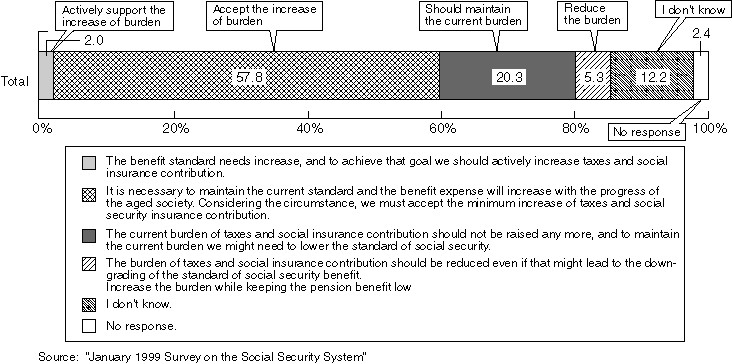
According to three survey results, "Public - Opinion Poll Survey on the Public Pension System" (March 1998) by the Prime Minister's Office, "Survey Results of Experts" (May 1998) by the Ministry of Health and Welfare, and "The Survey Results of College Students on the Public Pension System" (July 1998), many respondents support "Increase the burden while keeping the pension benefit low". This indicates that even in the specific area of pension, some increase of burden is necessary in order to maintain the long-lasting, stable and reliable pension system while the growth of benefit should be controlled to avoid excessive increase of burden on the working generation.
3. Different Views Towards the Aged Society in the 21st Century
3-1. Changing the View of Population Structure
Previously the rise of aging rate has been emphasized in the change of population structure, but during 1990s the ratio of working age population, which is the core of the labor force in the society (the population of age 15 to before 65), was the highest in the population structure after the war (about 69% in 1998). Even in the aged society in the 21st Century, the ratio of the working age population will not drop drastically, and around 2015 the ratio will reach to the level in 1950s (about 60%).
The attempt to categorize the age groups of population structure with a different perspective is also important.As an example, while a life span is 80 years, let's consider the population of age 70 or older as the equivalent of the conventional elderly of age 65 or older who are retired people in the society. On the other hand, considering the actual social condition, it is no longer suitable to include age 15 to 19 in the same group as age 20 or older. Based on these views, the population is demographically categorized into three groups of "Age under 20", "Age 20 to under 70", and "Age 70 or older". Figure 4-2-3 shows the changes in the ratio of each age group during the first half of the 21st Century.
Figure 4-2-3. Changes in the Population Structure of Japan
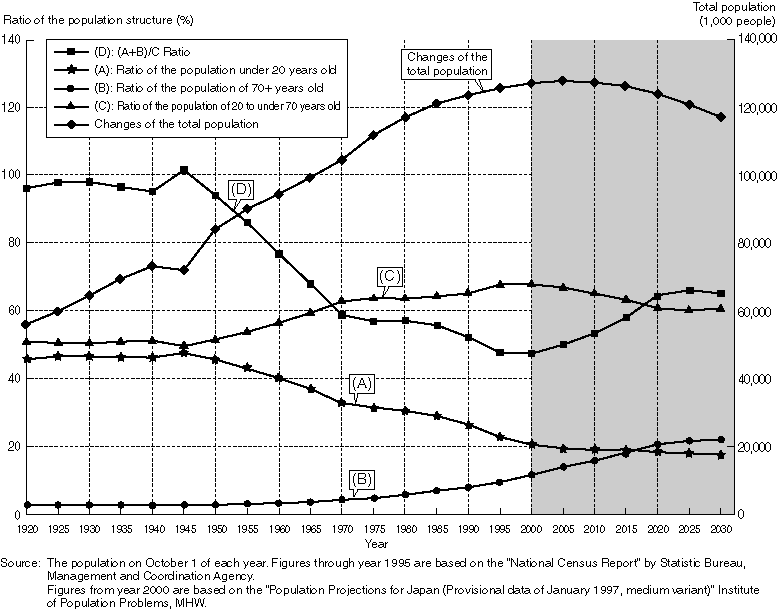
According to the projection, the population of age 20 to under 70 reaches the peak in around year 2000, and begins to decrease. Then, in 2015 it reaches to the level of 1985. The time when the population of age 70 or older exceeds the population of age under 20 is not before year 2015. The ratio of the population of age 70 or older in the entire population is 11.6% in 2000 (the ratio of age 65 or older is 17.2%), 15.8% in 2010 (22.0% for age 65 or older), and 20.5% in 2020 (26.9% for age 65 or older). The configuration looks different than the image created with the aging rate based on the elderly people of age 65 or older. The ratio calculated by dividing the sum of the population of age under 20 and 70 or older by the population of age 20 to under 70 has been steadily decreasing after the war, and during 1990s the ratio was below 50%. But it begins to rise after year 2000 and reaches to the level of 1970 in around 2015.
In the future, it is important for us to continue the adequate review of the social security system as well as social and economic systems to be compatible with the changes of population, population structure, the ratio of employed people, etc.
In addition, as explained later, treating the elderly in the early 21st Century as simply "the people to be supported by the society" may damage the pride of the generation that has developed the Japanese society until today. The elderly generation is expected to be "the generation to support the society" through vital activities.
(Changes of the labor force population)
According to the changes in the labor force population based on the projection by the Ministry of Labor, the labor force population during the early 21st Century continues to increase until around 2005, and then gradually decrease. It will reach to the level of 1990 in around 2020 (Figure 4-2-4). Japan will experience the decrease of labor force population for the first time, and it is expected to impact the economy. However, for a while the urgent issue is the employment measures for 3.39 million of unemployed people (as of March 1999), which is the highest number in the history.
Figure 4-2-4. Changes in the Population of Labor Force
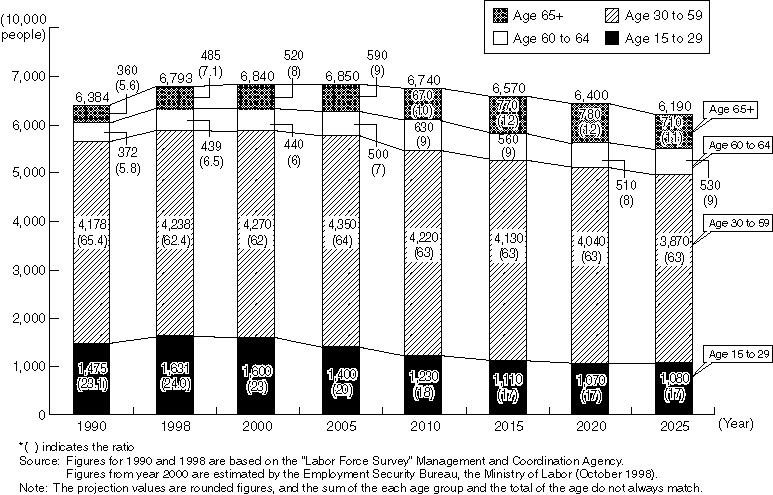
According to the future projection of the labor force population by the Ministry of Labor, the increase of the employed women and the elderly will become important. As we project that one in every five persons will be age 60 or older in around 2020, the aging of labor force population will advance, and we will need various measures such as to secure employment opportunities for the elderly, to develop skills, to facilitate work environment, etc. Also, in order to support the expansion of working women, it is essential to create work environment in which women can feel comfortable working.
3-2. Changing Our View Towards the Image of the Elderly
(We should not view all elderly the same)
As generations change through time, the image of the elderly also changes during the course of generation change within the elderly. Traditionally, the elderly has been viewed as the "the weak" all together, but does the current working generation view the elderly as "the weak of society"?
According to "January 1999 Survey on the Social Security System", the most common view was "Physically weak but not necessarily weak financially" 33%, followed by "Weak physically and financially" 26%, "Not weak physically or financially" 13%, "Financially weak, but not necessarily weak physically" 10%, and "Not sure" 18%.Many respondents considered the elderly as physically weak but they did not consider the elderly weak financially (Figure 4-2-5).
Figure 4-2-5. Views of the Elderly as "the Weak of Society" Physically and Financially
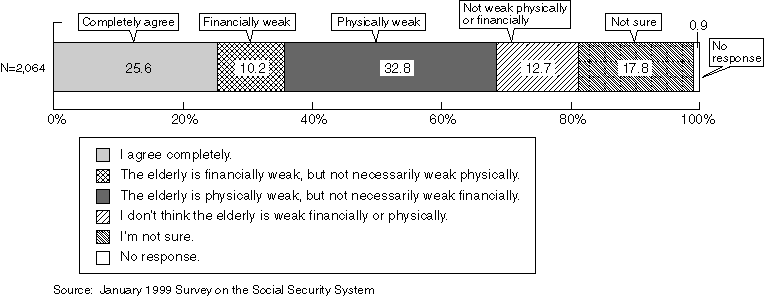
The recent population structure in Japan shows a number of phenomena that we did not find in the previous Japanese society. In 1996, the working age population (the population of age 15 to under 65) decreased from the previous year for the first time after the war. In 1997 the population of children (the population of age under 15) was less than the population of the elderly (the population of age 65 or older) for the first time. In 1998 the population of the elderly was 20.51 million and exceeded 20 million for the first time. This is the equivalent of the population of Tokyo and Kanagawa Prefectures. When we have 20 million of elderly people, treating them as "the same one group" will lead us to many problems.
(Diversification of the elderly)
First of all, the age range is very broad. The difference in age between 60s and 80s is almost one generation, and their difference is not only the standard of health and physical strength, but also the common sense of value and life experiences. Furthermore, compared to younger generations, individual differences within the same elderly generation is much greater in terms of the standard of health, income, assets, family environment, etc. Let's examine the diversity of the elderly of age 65 or older based on various data.
1 Population ratio of men vs. women and household structure
The ratio of men and women in the people of age 65 or older, the population of women is 1.4 times greater than that of men. The ratio of women increases in higher age, and the female population of age 85 or older is 2.4 times greater than the male population (Figure 4-2-6).
The living condition of the elderly with the family also varies. In general the ratio of the elderly living with the children is decreasing, and the ratio of the elderly-only households and the single living households is increasing. According to "1998 Comprehensive Survey of the Living Conditions of People on Health and Welfare", the number of households with the elderly of age 65 or older is about 14.05 million, which is 32% of the total. Among these households, the ratio of "households with three generations" is the highest of 30%, followed by "households with a wife and a husband only" (26%) and "single living households" (18%).
Figure 4-2-6. Ratio of Men and Women in the Elderly Population
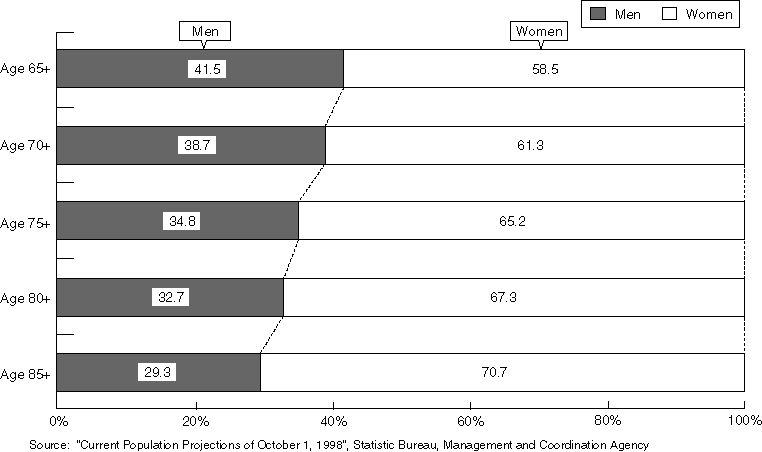
In case of elderly men, about 86% live with their spouse. A half of them are living with the spouse only, and a half of them are living with their children. In case of women, on the other hand, their spouses tend to have passed away earlier because of the age difference, and the ratio of women living without their spouse is higher than that of men. This tendency becomes more apparent and the ratio of people living with children also becomes higher. Approximately 20% of the total are living alone. However, the ratio of the elderly living with their children is decreasing every year, and the ratio in 1997 is 52% (Figure 4-2-7). Because the population of the elderly is increasing, the population of the elderly living with their children is greater than before, approximately 10 million.
2 The frequency of commuting to medical institutions and the probability of the conditions requiring long-term care
According to the frequency data of commuting to hospitals and clinics for medical care, about one in four persons responded "two to three time in a month" (28.5%), which is the highest number of responses, followed by "Not at all", which is also about one in four persons (27.1%). Other answers are "Once a month" (18.2%), "Once a week" (10.1%), and "two to three times in a week" (7.8%). About 2.4% of people responded "Everyday", but in general elderly people are not necessarily frequent users of medical care facilities. Although the frequency of using medical care institutions tends to increase with the age, one in six elderly persons of age 75 or older responded "Not commuting to medical care institutions" (Figure 4-2-8).
Figure 4-2-7. Ratio of the People Age 65 or Older by Gender, Age Group, with or without Spouse, and Family Structure (1997)
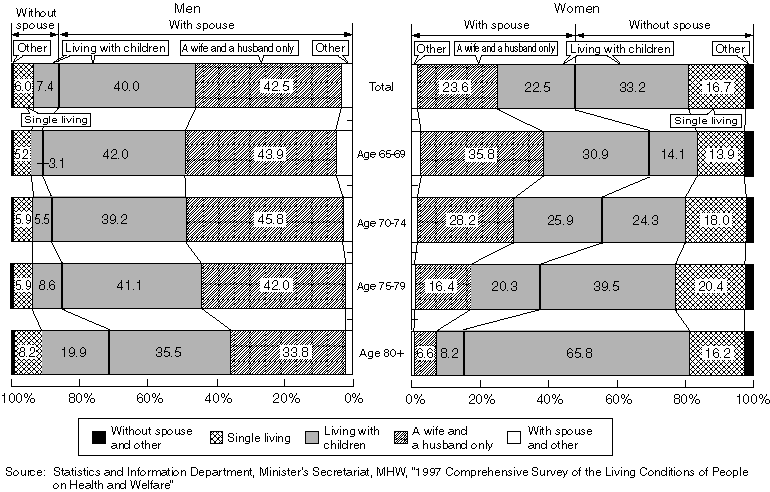
Figure 4-2-8. Frequency of Commuting to Hospitals and Clinics for Medical Care
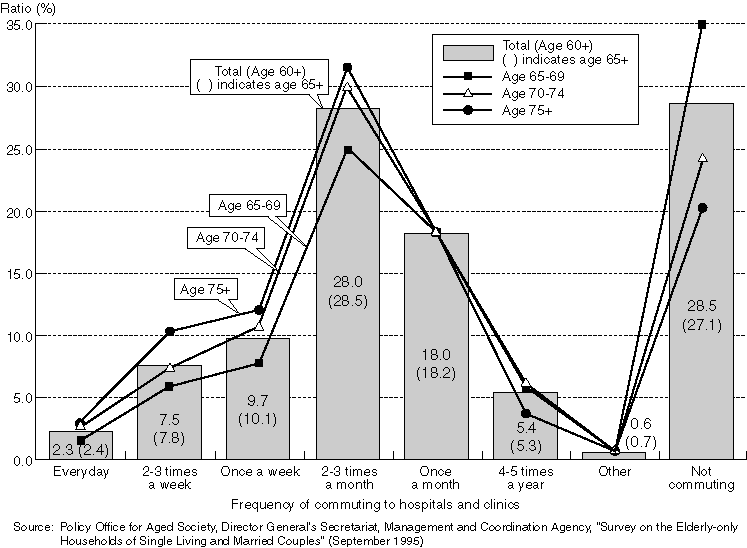
Figure 4-2-9. Occurrence Ratio of the Elderly Requiring Long-term Care
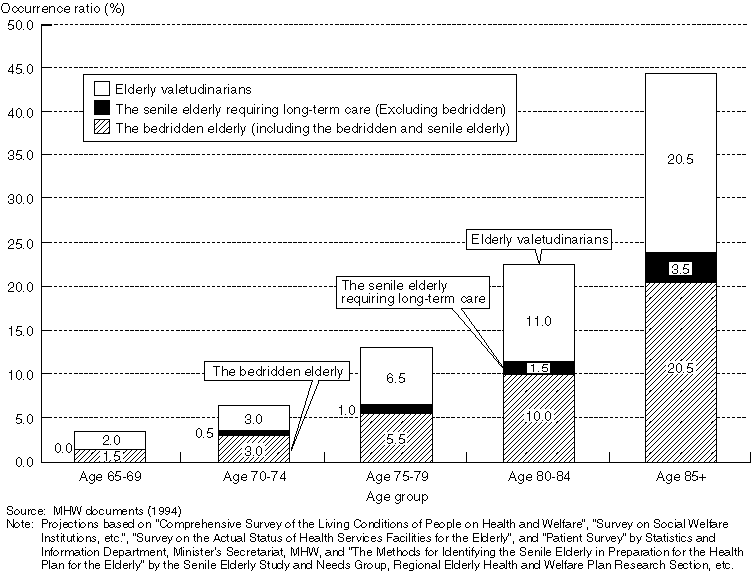
The ratio of people requiring long-term care (projection) is about 13% (including valetudinarians) of the total elderly population, and the ratio increases with older age, but the ratio is small for the elderly under 75 years old (Figure 4-2-9).
According to the distribution of income and assets of the elderly-only households (Households consisting of a husband of age 65 or older and a wife of age 60 or older only), some have small income and some have high income, and the amount of assets also varies greatly from small to large.
3 The status of income and assets
According to the distribution of income (annual), about 30% fall into "\3 million to \4 million" (about 28%).About 8 households per 100 households have the income of "Less than \2 million" (about 7.7%), 6 households per 100 households have the income of "More than \10 million" (about 5.8%) (Figure 4-2-10). For savings about 36 households per 100 households have "\20 million or more" (about 36%), 28 households have "\9 million to less than \20 million" (about 28%), and 9 households have "Less than \3 million" (about 9.3%) (Figure 4-2-11).
When we examine both income and savings, about 9% of total households have the income of "\8 million or more" with savings "\12 million or more", which is greater than the average income and savings of the current working generation. On the other hand, 3% of the total households have income of "Less than \3 million" with savings of "Less than \1.5 million".
Thus, the difference among elderly people is large in terms of health conditions and income. This implies that it is a problem to stereotype the elderly (an uniformed image based on a certain format) as a unified group with the same health condition and income level.
Figure 4-2-10. Income Range Distribution of the Elderly-only Households (1994)
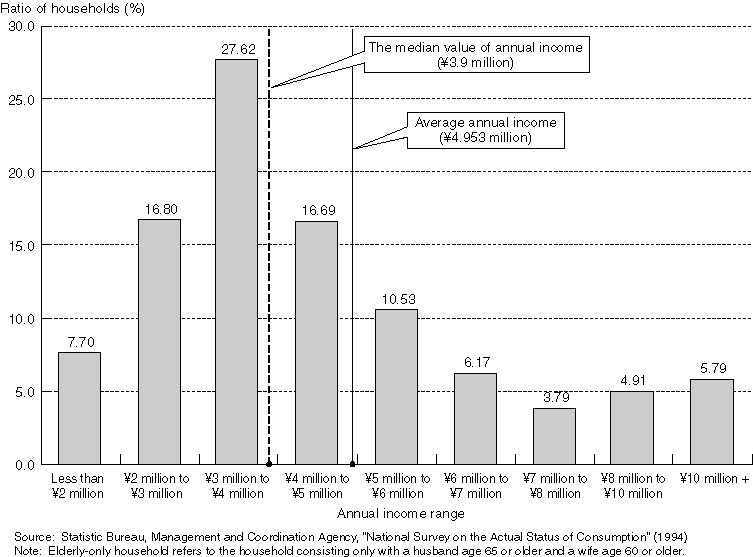
(A new elderly generation)
The majority of current elderly people were born in the Meiji and Taisho eras, but the elderly generation in the 21st Century will consist mainly with the people who were born in 1935 and later and who have supported the high economic growth after the war. After year 2010, "the post-war baby boomers" (the generation born between 1947 and 1949) who have supported the growth economy as well as the social culture of Japan will join the elderly generation of age 65+.
These generations have definite difference compared to the current elderly generation in terms of occupational experiences (e.g. mostly agricultural workers to mostly salaried workers), living experiences (e.g. rural living to metropolitan living and consumption oriented living), life experiences (e.g. war-time generation to the generation without war experiences), culture and common sense of values (e.g. different education in youth, so-called the 60's generation with the experience of the campaign against the Japan-U.S. Security Treaty and university disputes), consumption behaviors (e.g. the generation with the experiences of the enjoyment of consumption in affluent age), etc. They are also the generations with full awareness of the arrival of aged society with fewer children in the future. When these generations become the majority of the elderly generation, the image of the aged society is likely to change greatly.
In addition, the new generation of the elderly means the emergence of a great consumer group with diversified needs (demands) to give new opportunities to economic activities.
3-3. The Ageless Age
(Active aging)
In 1992 the United Nations General Assembly decided 1999 to be the "International Year of Older Person" to aim at the realization of "the U.N. principles for the elderly". "The U.N. principles for the elderly" refer to the five principles for the elderly, "Independence", "Participation", "Care", "Self-fulfillment", and "Dignity" (See the Column about the "International Year of Older People").
Figure 4-2-11. Savings Range Distribution of Elderly-only Households (1994)
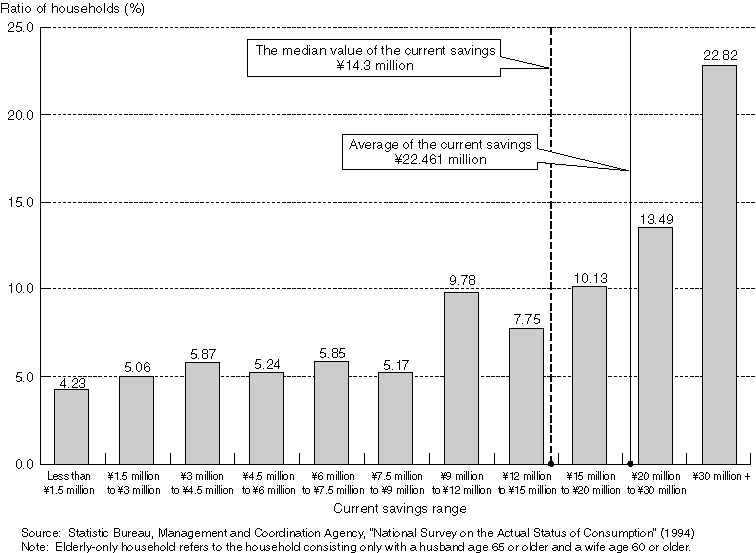
The theme of the International Year of Older Persons is "Towards a Society for All Ages". People might expect the year of older persons to be a year to focus on the elderly issues, but this theme introduces an unique concept that the issues of the elderly are not just for elderly people but for all generations and we should take actions to create a society in which both elderly and young people can live comfortably as members of the society and without treating the elderly differently.
This concept relates to the idea of "Active aging" presented in the Communique of the Denver summit in 1997."Active aging" means to promote the measures based on the positioning of the elderly to be the main participants in the society by liberating from the old prejudice of the elderly being the dependents.
(Ageless society)
In the light of these concepts, separating the elderly solely on the basis of age will raise a question in the aged society and such segregation may damage the collaboration among all generations. The Japanese society in the 21st Century will be in the era in which the elderly is no longer the minority in the population structure. As an example, it will become difficult to find socially rational reasons for the difference (e.g. the standard of co-payment for medical expenditures) in the social security benefits solely on the basis of the age as in the current practice.
As elderly people are becoming the majority in the aged society with fewer children in the 21st Century, it is important that they utilize their abilities and experiences to support the economic and local society with younger generations, and creation of such society is expected. Except for the issues with rational reasons to segregate people by age, "Ageless (no distinction by age)" age is expected to arrive for the issues for which it is irrational to make difference among generations solely on the basis of age.
Column
The world population is projected to exceed 6 billion people on June 16, 1999. In 1960 at the peak of the "Population explosion", the world population was three billion people. Although the speed of population increase is slowing down now, the world population has been increasing by 80 million people every year. Until a half way through the 21st Century, the population is expected to grow, and the aging population is expected to increase in developed nations (U.N. projection in 1998 indicates that the composition of the world population will be 30.6% under 15 years old, 62.7% age 15 to 64, and 6.7% age 65+.).
With the awareness of aging population worldwide, in the General Assembly of the United Nations in 1992 decided to make 1999 the "International Year of Older Persons" with the theme "Towards a Society for All Ages". Also, the General Assembly in 1990 decided that October 1 in every year be the "International Day of Older Persons". The "International Year of Older Persons" aims to promote the "U.N. principles for the older persons" (Decided in 1991 U.N. General Assembly), and to realize policies, actual plans and activities.
"The U.N. principles for the elderly" consist of the following five principles, and the U.S. recommends individual nations to incorporate the principles in their policies.
In preparation for the rapid progress of aging and for the arrival of fully established aged society, Japan has promoted all elderly related measures in the government based on the "Basic Principles of the Policy for Long Life Society" decided by the cabinet in June 1986. Currently, as stipulated in the Basic Law of the Aged Society Strategy, and based on the "Basic Principles of the Policy for Aged Society", comprehensive measures are promoted in various areas such as health and welfare services for the elderly, security of wages, social participation, life-long learning, housing, etc.
In preparation for the International Year of Older Persons, the "Liaison Conference Among Related Ministries and Agencies on the International Year of Older Person" was established in March 1998, and relevant ministries and government agencies are taking actions through close communication and collaboration. In the private-sector, the "NGO Liaison Conference for the International Year of Older Person" was formed in October 1998 with organizations related to the elderly issues, and it is taking actions for the memorial events for the year and for providing information to general public within the private-sector level. As of April in this year, the liaison conference has official members of 38 organizations.
(Logo mark: This logo mark expresses vitality, diversity, mutual support, movement, and development.)
|
(Elderly people are key members to support the society)
The ratio of the elderly in the labor force population of Japan is high for both men and women compared to the standards in the U.S. and Europe (Table 4-2-12). Particularly the ratio of younger elderly (young-old), age range of 65 to under 75, in the labor force population is exceeding 30%. Elderly people's motivation toward work will become the force to change the pessimistic view of the aged society with fewer children.
As an example, the life style of "Returning to agriculture after retirement" is capturing attention recently. This is a life style to engage in agricultural work as a hobby or farmer by growing rice and fruits after retiring from the life of salaried worker in a metropolitan area in their old age. According to the Ministry of Agriculture, Forestry, and Fisheries, about 30,000 people of age 60 or older have newly become farmers in 1997, and they are 50% of the total people who became new agricultural workers. Also, the ratio of middle to old generations to start new business "entrepreneurs" is increasing and their businesses are called "senior venture". According to the survey conducted by the Small and Medium Enterprise Agency, about 35% of new business owners since 1991 are in the age range of 40 to 49, and 37% are age 50 or older.
In any case, the elderly generation is expected to become the key members to support the society as "Active aging" generation. Knowledge, experiences and skills that they have accumulated in many years are expected to play important roles in the aged society with fewer children. From this point of view, it is necessary to change the social system and the awareness of people through promoting the employment of elderly people and developing the living environment where elderly people can easily lead their activities so that people can live with health and fulfillment throughout the long life.
4. Five Viewpoints to Consider the Social Security System in the Future
Based on the views towards the changes of population structure described in Section 3 and the view of new images of the elderly and aged society, we will present five viewpoints to consider the social security system in the future. It is important to review and revise the current social security system in a timely manner to be prepared for the social and economical changes as well as for the changes in people's living, and to improve the system through the cooperation among all members of the society while keeping these viewpoints in mind.
4-1. The Social Security System is an Infrastructure for Secure Living (Social capital)
Based on the analyses in Chapter 1 to Chapter 3, the outcomes of the social security system in Japan can be summarized as follows:
The social security system in Japan has been improved and developed with the goals to minimize the impact of various risks (danger) that may occur in the daily life and a long life span of a person, and to guarantee stable living. In order to support the individual efforts to achieve self-sufficiency and the function of family with the respect for the dignity of people, various facilities have been created and operated. So far, the social security system in Japan has been performing well in general, and has contributed to the stability of people's living, reducing the gaps between rich and poor, the improvement of the standard of living for the people with low income, support of individuals to become self-sufficient, support of the function of families, stable growth of economy, etc.
Figure 4-2-12. International Comparison of the Ratio of Age 65 or Older in the Labor Force Population
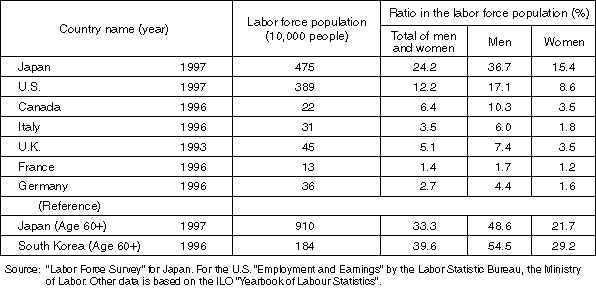
As explained in Chapter 2, the social security system has a role to function as "a safety net of the society" to enable people to maintain their lives with a sense of security or to restart their self-sufficient living after becoming ill or disabled, or losing the way to gain income. Individual systems within the current social security system are now integrated into the lives of all people, from infants to elderly people, from single living households to households with multi-generations, and from home to work place, and they are essential to our daily living. Because of the social security system, people are able to proceed with their daily living and to conduct economic activities without difficulties. In other words, the social security system is supporting the vitality of the economic society and the activities of people.
The social security system with these roles can be positioned as an indispensable fundamental element of "Infrastructure for people's living (social capital)" of our society in the same way as transportation networks of highways and railways, public facilities such as water works and sewage and parks, policemen and fire fighters, education, etc. Everybody is supporting the social security system, and we must enhance the infrastructure that we named the social security system by effectively utilizing the burden of social insurance contributions and taxes.
As we reviewed in Section 4 of Chapter 2 and Section 4 of Chapter 3, there are about 4.5 million people engaged in the social security related work, and many of them are important human resources with professional skills in health and medical care and in welfare field with high moral standard.
4-2. Rebuilding the Awareness of Social Solidarity
Recently, the concept of "intergenerational support" (or intergenerational solidarity) is used in the discussion of the social security burden for the working generation and the elderly generation when revising the pension system, health service system for the elderly, establishment of long-term care insurance system, etc.Specifically, this is a concept that the working generation bears the burden of pension and medical cost for the elderly generation, and when they reach the advanced age, the younger generations will bear the burden of pension benefits.
As analyzed in Chapter 2, the revenue redistribution function of the social security system is working effectively by transferring a large amount of revenue from the elderly generation to the working generation through the pension and medical care systems within the social security system. By adopting the mechanism of intergenerational support in which the working generation bears the expenditures for the pension benefits and medical care for the elderly, in case of the pension system as an example, we have been able to maintain the actual value of the pension using the price indexation, and in case of the health service system for the elderly, the patients have been able to receive medical services with a small co-payment.
However, the basic framework of these systems were designed in the earlier stage of the aged society, and in the current population structure formed with the rapidly increasing aging population with fewer children there is a potential for the burden of the working generation to become too heavy because of the large number of elderly people, and it will be necessary to balance the benefit and burden. In addition, the elderly generation is becoming the majority in the society, and treating all elderly people as the subject for the pension benefits without considering the diverse range of income and assets owned by the elderly and without any rational reasons but solely on the basis of age, or not requiring capable people to bear the burden, will lead to the increase of burden on the working generation through the benefits paid to elderly people as their population increases. The results of these are making the working generation feel worried about the social security system with heavy burden.
While aging rate is rising and the population is decreasing, the system that concentrates the burden on the working generation might create the feeling of heavy burden on the working generation for the social security system, and generate the negative idea towards the intergenerational support and social solidarity.
Subsequently that might threat the foundation of the social security system. As shown in Figure 4-2-13, the opinions on the system based on the concept of intergenerational collaboration by the current working generation are about 60% "agree" and about 40% "disagree", and the response of the people in their 20s are about the same for both agree and disagree.
Figure 4-2-13. Mechanism of the System Based on the Concept of "Intergenerational Collaboration"
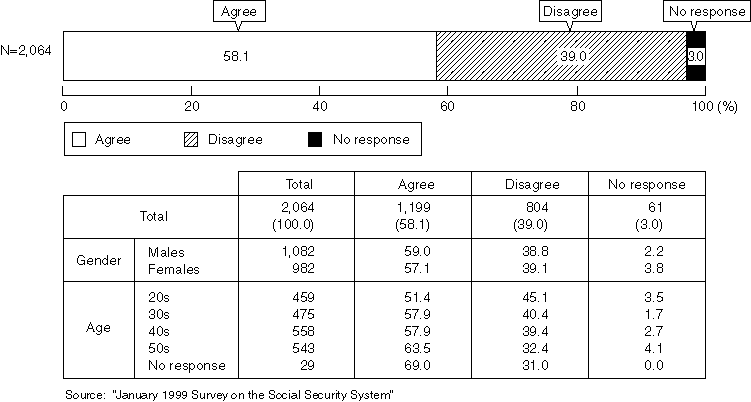
The social security system is supported by the concept of social solidarity in which people in the society support each other with the basic concept of individuals to be self-sufficient. It is important to mutually support and develop the social security system by having all generations, particularly the young generations to carry on the future society, to correctly understand the contents and the meaning of the social security system. In order to achieve this goal, it is mandatory to design and manage the system to rebuild the awareness of social solidarity by adjusting the imbalance of the benefit and burden between the elderly generation and the working generation. Considering the relation of the social security burden between the elderly generation and the working generation, it is necessary to reconsider the methods to bear the burden of various systems based on the concept of "the same burden for the people with the same capability to bear the burden" in the 21st Century as the population of the elderly increases and the ratio of working generation decreases.
In order to prevent the weakening of the social solidarity awareness and to maintain the awareness in the future, it is necessary to support the social security system with all generations and all people, rather than to have a certain generation to support and a certain group of people is supported. We must create a system to reflect this idea in reality.
4-3. Developing the Social Security System to Meet the Changes in Family Structure and the Society with Fewer Children
(Promoting the actions for having fewer children)
The social security system in Japan has concentrated its efforts on the measures for the aged society by focusing on the pension and medical care systems (See Section 2, Chapter 3), but while aging population is increasing, marriage age is becoming higher (the ratio of the unmarried is increasing among young people) and the number of children is decreasing.
In "1999 edition of Annual Report on Health and Welfare" we discussed the topic of having fewer children, and raised the issues for the national debates with the vision of families, communities, work places and schools to form "a society in which people can have a "dream" of bearing and raising children". Later the "Conference of the Learned to Consider the Measures for the Society with Fewer Children" was held with the host by the Prime Minister, and the participants recommended to develop the environment where both men and women can realize diversified working styles and life styles to maintain the balance between their responsibilities with families, communities and work, and where children can grow with the sense of freedom and enjoyment (December 1998). As pointed out in this recommendation, the development of these environments is an action for the society with fewer children and also desirable as a measure for aged society. It is important to further develop this country to become a society where everybody can feel comfortable to live in.
There are many actions to be taken to develop the desired environment, and comprehensive projects such as to create the environment to allow compatibility of work and child care for both men and women are becoming much more important than before. Because such projects involve many issues concerning the awareness and customs of people, they need to be long-term projects supported by all citizens, and many issues are concerning the social security system such as the development of high-demand services including nursery care for young children in cities, offering diversified services to meet the changes of life styles, efficient offering of high quality services, securing the quality of nursery care based on the view of children, and examining the ways to socially support the economic burden of child rearing. In the future development of social security measures, the promotion for the actions towards the issues of fewer children would be an important element.
In addition, those measures to support child rearing are not limited to the actions for the issue of fewer children but to contribute to the creation of the society where both men and women can participate and be effective by having a wide range of selections available in life with the potential for continuing both child care and career instead of the conventional practice of interrupting career for child rearing.
(Changes in family structures)
The environment surrounding the social security system is changing everyday beyond the progress of the aged society with fewer children. The most representative change is the change in family structures.
After the war, the size of family has been shrinking consistently, and the trend is expected to continue in the future. According to the "Projected Number of Households in Japan" (October 1998) by the National Institute for Social Development and Population Problems, MHW, the average size of households will decrease from 2.82 people in 1995 to 2.49 people in 2020, and the number will reach to the level of Scandinavian nations which have a small number of people in the households within European nations. As indicated in Figure 4-2-14, the ratio of households by structure indicates that about 15 million households, 34% of the total households, are "With a married coupe with children" in 1995, but the number decreases to 13 million households, 27%, in 2020, and the number of "Single living households" increases from 11 million to 14.5 million, that is from 26% to 30% of total households, and the ratio of "Single living households" becomes the greatest among different household structures.
During the early 21st Century, one in three households will be single living and the households with "a married couple with a child (children)" will no longer be the standard. Some of the benefits and systems within the social security system are created based on the standard household with "a married couple with a child (children)", but in the future such system will need to be revised to base single living household (a household with one person). Although the social security system should not damage family relationship or enforce a certain relationship for a matter of formality, it will become important to further consider one of the functions of the social security system to support family functions.
4-4. Comprehensive Social Security System and the Enhancement of Merger and Collaboration between the Administrations for Health, Welfare and Labor
(Creating a comprehensive social security system)
With the improvement of the social security system, comprehensive adjustment between systems becomes important. As an example, the public long-term care insurance system to be implemented in April 2000 was established with an objective to correct the incompatibility between independent welfare and medical care systems for the elderly. However, we must continue monitoring the implementation status and examine the alignment among the medical insurance system, welfare measures for the people with disabilities, etc.
Figure 4-2-14. Changes in the Number of General Households by Family Structure
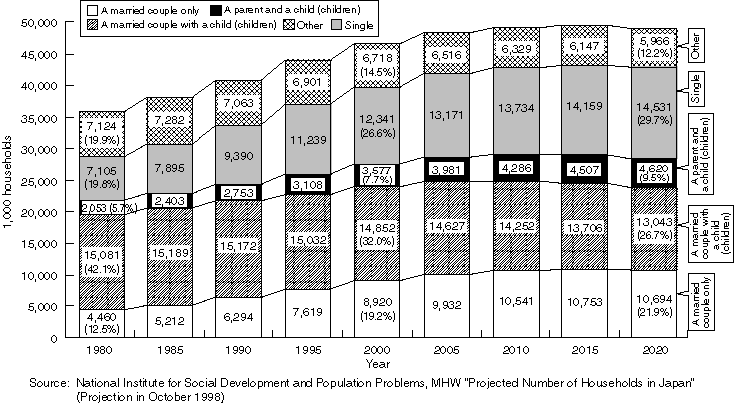
When we examine the measures concerning the elderly only, we can find some systems that lead to the same results although they were established for different purposes. A specific example is that the medical insurance system, which ensures the coverage of medical expenditures (the health service system for the elderly in case of the elderly), and the pension system, which ensures the financial security for the retirement life, are completely different systems within the social insurance system in terms of their purposes, configuration of the fund sources, methods of providing insurance benefits, etc. However, both systems play the same roles to function as the security for living. The public long-term care insurance system also has the function to secure the living of people requiring care. While these three systems improve the security of living in the advanced age, providing the benefits of these systems through different channel is inefficient and mutual adjustment is necessary.
Thus, as a result of the expansion of range and scale of the social security system, it is necessary to review individual systems and their operations and to make adjustment with sufficient consideration of the mutual relationship among individual systems. Otherwise, in addition to the issues of operational inefficiency of individual systems we will encounter some problems on the impartiality of benefit and burden for the current working generation that is bearing heavy burden of the benefits for the elderly.
(Enhancement of the merger and collaboration between the administrations for health, welfare and labor)
Many issues on the social security system and labor related issues are closely related. Here are some examples: the relation between the pension system and employment; measures to support the compatibility of child care and job, and such measures are key to the development of the environment to promote the measures for the fewer children; the relation between health and welfare services for the people with disabilities and the employment for those people; long-term care insurance and the long-term care leave system, etc. In the deployment of various measures it is important to consider the mutual relationship of these systems. In 2001, the Ministry of Health and Welfare and the Ministry of Labor will be scheduled to merge to form "the Ministry of Welfare and Labor", and the enhancement of the merger and collaboration between the administrations for health, welfare and labor, is expected to realize efficient and effective administration of the social security system. Obviously the employment measure is most urgent at this time considering the serious unemployment condition with the highest unemployment rate after the war. It is important to implement the measures to improve welfare through the collaboration between the employment system and the social security system based on the concept to realize the society where people can work with the sense of security with adequate employment measures and achieve self-fulfillment by maximizing the usage of own capabilities.
4-5. Vitalizing Local Communities through Welfare Improvement
(Promoting the decentralization of power and "Community development with welfare")
1990s are special years when the actions for the decentralization of power progressed remarkably to enhance the self-motivation and independence of local communities by clarifying the roles of the national government and local administrative functions. In May 1995, the Law to Promote the Decentralization of Power was established, and then the Promotion Committee for the Decentralization of Power was formed in the Prime Minister's Office. The committee provided several recommendations to the Government, and the cabinet made a decision on the Promotion Plan for the Decentralization of Power in May 1998. In March 1999 a "Single Legislative Package Bill on the Decentralization of Power" was submitted to the Diet. The key issues of the bill are to facilitate necessary laws such as to abolish the system of administrative work commissioned by the central government and to restructure the segmentation of administrative work, to reduce the involvement of national government, to promote the delegation of authority, streamlining the regulations for various actions, and to revise the laws for the development and establishment of administrative functions in local communities.
In the Health and Welfare administration, a large portion of social welfare related administrative work was commissioned by the central Government functions, but around the mid-1980s the delegation of authorities started, and in 1990s social welfare laws were revised to make the municipality, which is the closest entity to the residents, the responsible body for welfare services. The recent "Single Legislative Package Bill on the Decentralization of Power", revised various relevant laws, and most administrative work for welfare services are now under the management of municipal offices. This change has expanded the range of items that the municipality can decide at its discretion. This also means to increase the responsibility of the residents. Until 1986, when the administrative work for the admissions to nursery centers and to welfare facilities for the elderly was delegated to the municipality, most administrative work for social welfare was commissioned by the institutions and it had to be processed in an uniformed manner nationwide. These days, the basic approach is that the municipal office leads the efforts in response to the requests of the residents, and the trend of this approach will accelerate in the future.
Welfare measures are one of the most important issues for municipal administration, and its approach is expected to become an index to assess how much the municipality is responding adequately to the demands of the residents. The milestone for the near future would be the degree that the public long-term care insurance system can meet the expectation of the residents, as the municipality becomes the insurer. In addition, as reviewed in Section 3 of Chapter 3, the social security system impacts greatly to the local economy, and for the aged society with fewer children in the 21st Century, the active efforts for creating a community focusing on the improvement of welfare will lead to vitalizing the community and to the creation of new local culture.
(Promotion of residents' participation and trans-regional administration)
The implication of the decentralization of power is not limited to the mutual administrative relationship between the national government and the local government bodies, but also for the deployment of local government administration led by the local residents through the decentralization. It is important that the local residents actively participate in the development of administrative plans, and it will be necessary to have the mechanism to reflect the residents' opinions. Regarding this point, the public long-term care insurance system includes the clause that stipulates that the insured opinions must be reflected in the creation of the long-term care insurance business plan, and various local communities are developing plans that encourage residents' participation.
In order to respond to the demands (needs) of the residents adequately and efficiently, the geographical divisions of the municipality need flexibility in accordance with individual administrative issues. In the past, some municipalities have taken trans-regional actions for certain projects such as waste disposal and public water works and sewage. Particularly in case of the public long-term care insurance system, there have been many efforts made to respond the needs through cooperative efforts of multiple municipalities and the utilization of the trans-regional alliance system. These actions have high potential to trigger the changes in local administration in the future.
Column
in which the Residents Participate>
Saihaku-cho is a town in a hilly and mountainous area located at the west end of Tottori Prefecture, with about 8,300 people in population and about 83 km2 of land area with about 80% forest. It is a town of elderly people with the aging rate of about 25% that means that one in four persons is age 65 or older. The town created "the Committee to Create a Lively Town of Saihaku (commonly known as 100 people-committee)" on December 5, 1998 to create a public long-term care insurance system with residents' participantion.
The committee members are selected through a public appeal system. The announcement notes were distributed to all households in the town, and all applicants to the position (98 people, with 38 men and 60 women) were appointed to the member. The members consist of people in their 20s to 80s of both young and older, and men and women, but about 60% of the total are women of age 40s to 60s, who are the providers or likely to become the providers of long-term care in near future and feel the long-term care a relevant issue to themselves. The members' occupations are in a wide variety; matrons, nurses, company employees, agriculture, public services, housewives, etc.
The committee holds a meeting every once a month, and between December 1998 and March 1999 it held study sessions on the public long-term care insurance system with all committee members, and starting in April the members have been working in five groups with a specific theme to discuss (fulfillment measures, assessment for the certification for long-term care need, support of self-sufficiency, contents of long-term care services and the relationship between welfare and medical care, in-home services and institutional services, etc.). The committee is expected to provide specific recommendations based on those discussions ultimately, and then to monitor the public long-term care insurance system to make sure that it is operating properly.
A new project to develop the town is about to begin with the participation of residents using the occasion to implement the public long-term care insurance system.
<Joint efforts of 3 cities and 1 town of Northern Chita
in Aichi Prefecture using the trans-regional alliance>
In preparation for the implementation of the public long-term care insurance system, three cities and one town(cho) consisting of Tokai City, Obu City, Chita City and Higashiura-cho located in the south of Nagoya City, at the joint of Chita Peninsula, established a trans-regional alliance to jointly process the administrative work for the long-term care insurance.
The size of these three cities and one town is about a core city with the population size of about 0.3 million people, and the 150km2 of land area. Each of these cities and town has the aging rate of about 12%, which is lower than the national average. The progress with the plans for health and welfare for the elderly is going smoothly according to the progress rate of the three cities and one town, with an exception of the progress for the small fee-charging long-term care home for the elderly (Care house). In addition, the three cities were not included in the municipalities with the ordinary grant tax of the local grant tax in fiscal 1998. In such condition, it is very unusual to implement the public long-term care insurance system trans-regionally.
In the background to the implementation of the public long-term care insurance system by the trans-regional alliance, the three cities and one town have had exchanges of people and goods, and close relationship in administration for a long time, but the direct reason for the joint efforts was the commencement of the project in April 1997 for urban Cable TV ("Chita medias network") which covers the area including the three cities and one town in the northern part of Chita, and these cities began to develop close cooperative relationship as they share information.
In June 1998, in the "Trans-regional Alliance Liaison Meeting" consisting with the mayors of the three cities and one town reached the agreement on the implementation of the long-term care insurance by the trans-regional alliance, and in December 1998, the council of each municipality agreed to establish the alliance. Then, in March 1999, the governor of Aichi Prefecture issued the authorization for the establishment of the alliance, and "North Chita Trans-regional Alliance" was established on June 1. Expected benefits for this approach are 1 the improvement of special benefits of municipality, 2 the promotion of the participation by private-sector companies through the expansion of the market size for the long-term care services, 3 cost reduction for manpower and the cost for the administrative work processing system, etc.
Based on the trans-regional plan and while enhancing the cooperation among the member cities, the "North Chita Trans-regional Alliance" will jointly process all administrative work concerning the long-term care insurance, including the qualification management of insured, certification of requiring long-term care (requiring support), insurance benefits, health and welfare services, formulation of long-term care insurance business plans, etc. |